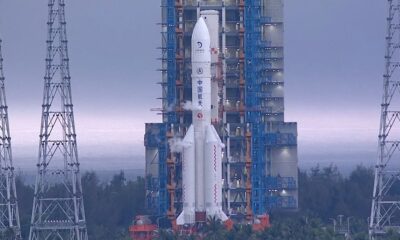Science & Technology
Google temporarily disables Google Maps live traffic data in Ukraine

Alphabet Inc’s (GOOGL.O) Google confirmed on Sunday it has temporarily disabled for Ukraine some Google Maps tools which provide live information about traffic conditions and how busy different places are, Reuters reported.
The company said it had taken the action of globally disabling the Google Maps traffic layer and live information on how busy places like stores and restaurants are in Ukraine for the safety of local communities in the country, after consulting with sources including regional authorities.
Ukraine is facing attacks from Russian forces who invaded the country on Thursday. As missiles fell on Ukrainian cities, nearly 400,000 civilians, mainly women and children, have fled into neighbouring countries, Reuters reported.
Russia calls its actions in Ukraine a “special operation”.
Big tech companies including Google have said they are taking new measures to protect users’ security in the region.
According to Reuters online services and social media sites have also been tapped by researchers piecing together activity around the war.
A professor at California’s Middlebury Institute of International Studies said Google Maps helped him track a “traffic jam” that was actually Russian movement towards the border hours before Russian President Vladimir Putin announced the attack.
Google said live traffic information remained available to drivers using its turn-by-turn navigation features in the area, read the report.
Science & Technology
China launches historic mission to retrieve samples from far side of the moon

China on Friday launched an uncrewed spacecraft on a nearly two-month mission to retrieve rocks and soil from the far side of the moon, the first country to make such an ambitious attempt.
The Long March-5, China’s largest rocket, blasted off at 5:27 p.m. Beijing time (0927 GMT) from Wenchang Space Launch Center on the southern island of Hainan with the more than 8 metric ton Chang’e-6 probe.
Chang’e-6 is tasked with landing in the South Pole-Aitken Basin on the far side of the moon, which perpetually faces away from the Earth, after which it will retrieve and return samples.
The launch marks another milestone in China’s lunar and space exploration programme.
“It is a bit of a mystery to us how China has been able to develop such an ambitious and successful programme in such a short time,” said Pierre-Yves Meslin, a French researcher working on one of the scientific objectives of the Chang’e-6 mission.
In 2018, Chang’e-4 gave China its first unmanned moon landing, also on the far side. In 2020, Chang’e-5 marked the first time humans retrieved lunar samples in 44 years, and Chang’e-6 could make China the first country to retrieve samples from the moon’s “hidden” side.
FOREIGN PAYLOADS
The launch was attended by scientists, diplomats and space agency officials from France, Italy, Pakistan, and the European Space Agency, all of which have moon-studying payloads aboard Chang’e-6.
But no U.S. organisations applied to get a payload spot, according to Ge Ping, deputy director of the China National Space Administration’s (CNSA) Lunar Exploration and Space Program.
China is banned by U.S. law from any collaboration with the U.S. space agency, NASA.
“The far side of the moon has a mystique perhaps because we literally can’t see it, we have never seen it apart from with robotic probes or the very few number of humans that have been around the other side,” said Neil Melville-Kenney, a technical officer at ESA working with Chinese researchers on one of the Chang’e-6 payloads.
After the probe separates from the rocket, it will take four to five days to reach the moon’s orbit. In early June a few weeks later, it will land.
Once on the moon, the probe will spend two days digging up 2 kilogrammes (4.4 lb) of samples before returning to Earth, where it is expected to land in Inner Mongolia.
The window for the probe to collect samples on the far side is 14 hours, compared to 21 hours for the near side.
The samples brought back by Chang’e-5 allowed Chinese scientists to uncover new details about the moon, including more accurately dating the timespan of volcanic activity on the moon, as well as a new mineral.
Ge said the scientific value of Chang’e-6 lay in the geological age of the South Pole-Aitken Basin, which his team estimated was about 4 billion years, much older than the samples previously brought back by the Soviet Union and the United States, which were about 3 billion years old, as well as the 2-billion-year-old samples from Chang’e-5.
LUNAR BASE
Besides uncovering new information about the celestial body closest to Earth, Chang’e-6 is part of a long-term project to build a permanent research station on the moon: the China and Russia-led International Lunar Research Station (ILRS).
The construction of such a station would provide an outpost for China and its partners to pursue deep space exploration.
“We know that the moon may have resources that could become useful in the future, so the European Space Agency, NASA, the Chinese agency and others around the world are going to the moon,” said James Carpenter, head of the ESA’s lunar science office.
“Part of the rationale is to understand those resources,” Carpenter said.
Wu Weiren, chief designer of the Chinese Lunar Exploration Project, speaking at the 2024 China Space Conference last month, said a “basic model” of the ILRS would be built by 2035.
(Reuters)
Science & Technology
Apple set for big sales decline as investors await AI in iPhones

Apple’s (AAPL.O), opens new tab plan to add generative AI to its iPhones and revive sagging sales in the crucial Chinese market will be in focus on Thursday, when the tech giant is expected to report its biggest quarterly revenue decline in more than a year, Reuters reported.
Long considered a must-own stock on Wall Street, Apple shares have underperformed other Big Tech companies in recent months, falling more than 10% this year as fears mount about its slow roll-out of artificial intelligence services and as a resurgent Huawei (HWT.UL) takes market share in China.
Analysts on average see iPhone sales, which account for about half of Apple’s revenue, falling 10.4% in the first three months of 2024, according to LSEG. That drop would be the steepest in more than three years.
The year-ago iPhone revenue that the 10.4% iPhone sales drop is measured against was unusually high as Apple satisfied pent-up demand after the COVID pandemic, company executives previously noted.
At least $5 billion of the $51.3 billion in iPhone sales a year ago was essentially catching up from disruptions in the December 2022 quarter when COVID lockdowns in China hampered iPhone production, executives said.
Even with that factored in, Wall Street expects a slight decline in iPhone sales, and analysts estimate Apple’s total revenue declined 5% in its fiscal second quarter ended in March. That would be Apple’s biggest revenue decline since the December 2022 quarter, when revenue fell 5.5%, read the report.
Apple earlier this year lost the crown of the world’s most valuable company to Microsoft (MSFT.O), opens new tab. Its market value stands at $2.68 trillion after the share price declined 11.24% so far this year.
Weak revenue and falling shares have pressured Apple to spruce up its flagship device after years without major upgrades.
The company is in talks with OpenAI and Alphabet-owned Google to add genAI features for the iPhone that could be unveiled at what is expected to be its biggest-ever annual developer conference in June, Bloomberg News has reported.
According to Reuters analysts believe such an AI integration could drive demand for the next iPhone series, expected to be announced in the fall.
While executives at Microsoft, Alphabet (GOOGL.O), opens new tab, Meta Platforms (META.O), opens new tab and other major technology firms have talked up their AI strategies on quarterly conference calls in recent months, Apple CEO Tim Cook has discussed his plans for the emerging technology much less.
Adding AI features to iPhones could also help Apple to compete better with Huawei and Samsung Electronics (005930.KS), opens new tab, which reclaimed the title of the world’s top smartphone vendor from Apple this year, driven by demand for the AI features in its Galaxy S24 smartphones.
“Replacement cycle tailwinds and incremental generative AI features set up Apple well for a strong iPhone 16 cycle,” Bernstein analyst Toni Sacconaghi said this week as he upgraded the company’s shares to “outperform” from “market-perform.”
“We believe prevailing weakness in China is more cyclical than structural, and note historically Apple’s China business has exhibited much higher volatility than Apple overall, given its very feature-sensitive installed base.”
Thursday’s earnings will also be watched closely for updates on the company’s stock buyback plan and the Vision Pro, Apple’s first major product in years that hit the shelves in February.
After initial enthusiasm, there have been signs that demand slowed for the $3,500 device, with an analyst saying this month that Apple has pulled back its production estimates for the mixed-reality headset.
The rest of the company’s hardware business is also reeling from soft demand, with iPads and Mac sales expected to fall 11.4% and 4.3%, respectively, in the March quarter, Reuters reported.
Apple has signaled it is sharpening its focus on the devices, which have also been hobbled by a lack of major upgrades.
At an Apple event this month, a revamped iPad line-up is expected to be unveiled and media reports have said that it plans to update every Mac model with faster, AI-focused M4 processors.
The services business, which includes App Store and subscription services such as Apple TV, is expected to remain a bright spot with revenue growth of 7.7%.
Apple shares closed down 0.6% at $169.30 on Wednesday.
Science & Technology
Mercedes Benz unveils electric G-class at Beijing Auto Show

Mercedes Benz has chosen China, its largest market, to unveil its groundbreaking pure electric vehicle and advance its electrification strategy.
Markus Schafer, Mercedes Chief Technology Officer (CTO), said the company was dedicated to making more sustainable products.
He stressed the sheer size of the Chinese market as its reason for choosing the ongoing Beijing Auto Show for the debut showcase of its electrified G-class 4×4 SUV.
“China is our biggest market, our most important market. And secondly, Mercedes decided to go all electric with our fleet going into the next years and [it’s] very, very important to provide customers access to an electric G wagon next to the combustion engine cart, so this is an iconic model, very important for the company. And we are so pleased to offer it now electrically,” said Schafer.
The CTO said Mercedes Benz plans to increase its investment in China by expanding crucial Research and Development activities.
-

 Sport2 days ago
Sport2 days agoAfghanistan announce T20 World Cup 2024 squad
-

 Sport4 days ago
Sport4 days agoKohli slams strike-rate talk and pundits ‘from the box’
-

 World4 days ago
World4 days agoBlinken arrives in Saudi Arabia to discuss Israel normalization, post-war Gaza
-

 Latest News5 days ago
Latest News5 days agoGhori State Cement in Baghlan increases production
-

 Regional4 days ago
Regional4 days agoDubai ruler approves new $35 billion airport terminal
-

 Health4 days ago
Health4 days agoNationwide polio vaccination campaign kicks off across Afghanistan
-

 Sport2 days ago
Sport2 days agoNew Zealand to go ahead with Afghanistan cricket Test
-

 Science & Technology4 days ago
Science & Technology4 days agoMercedes Benz unveils electric G-class at Beijing Auto Show

























